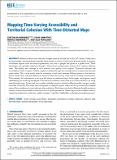Mapping Time-Varying Accessibility and Territorial Cohesion With Time-Distorted Maps
Author(s)
Balsa-Barreiro, Jose; Ambuuhl, Lukas; Menendez, Monica; Pentland, Alex
DownloadPublished version (1.557Mb)
Terms of use
Metadata
Show full item recordAbstract
© 2013 IEEE. Human societies have radically changed from the second half of the 20th century. Urban areas are increasingly concentrating more people and economic activities. Connections between market economies in different regions have increased exponentially the flow of people and goods at a global level. These movements are spatially organized through a hierarchical transportation network that connects different areas. The quality and coverage of such network vary greatly across regions. Territorial cohesion and accessibility within a region could be roughly evaluated through the existing level of connectivity between urban nodes. This can be easily done by estimating travel times between different points in the territory, which would show relevant differences based on both the territory itself and the existing infrastructure. Unfortunately, this information is not typically shown in traditional maps. In this paper, we propose a novel methodology for assessing the degree of territorial accessibility within and across urban networks, by using time-distorted maps. To this end, we consider multiple scenarios related to different public transport modes and times of the day. The study area corresponds to a Spanish region, where we set up a relatively extended network by considering its most relevant cities and towns. Final maps can clearly illustrate the deficiencies in transport infrastructure and/or connections from a spatial perspective. These maps can be excellent tools for supporting technicians, politicians, public managers, and other stakeholders in the decision-making process.
Date issued
2019Department
Massachusetts Institute of Technology. Media LaboratoryJournal
IEEE Access
Publisher
Institute of Electrical and Electronics Engineers (IEEE)